
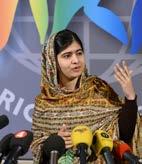
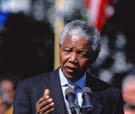
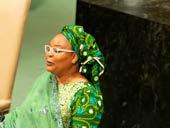
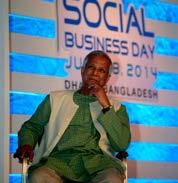
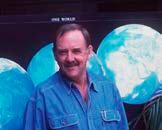
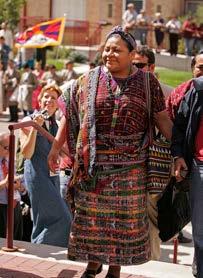
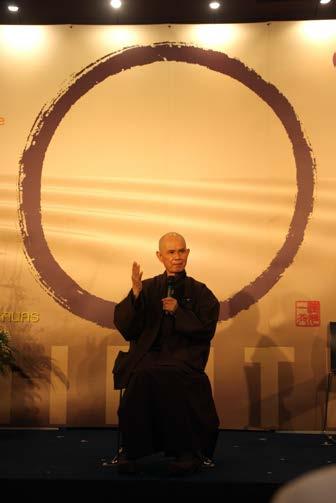
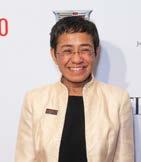
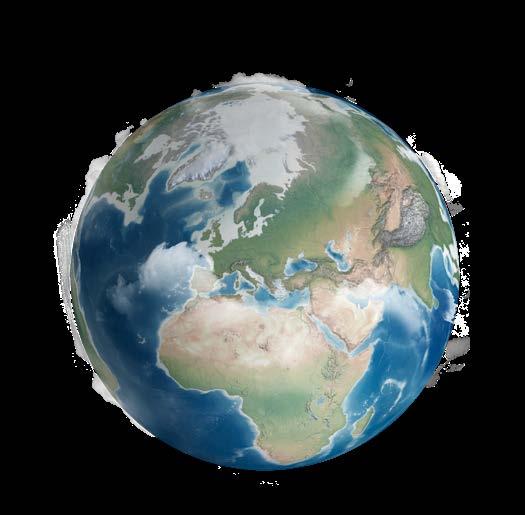
Stage 3 B1 Non-Fiction Young Adult Readers
Downloadable Audio Files
Chiara Michelon CHANGING THE WORLD!
The ELI Readers collection is a complete range of books and plays for readers of all ages, ranging from captivating contemporary stories to timeless classics. There are four series, each catering for a different age group: First ELI Readers, Young ELI Readers, Teen ELI Readers and Young Adult ELI Readers. The books are carefully edited and beautifully illustrated to capture the essence of the stories and plots. The readers are supplemented with ‘Focus on’ texts packed with background cultural information about the writers and their lives and times.
B1 YOUNG ADULT
READERS
CHANGING THE WORLD!
CHIARA MICHELON
YOUNG ADULT
READERS
Chiara Michelon
Changing the World!
English version
Pauline Russo
YOUNG ADULT ELI READERS
Series Editors
Paola Accattoli, Grazia Ancillani, Daniele Garbuglia (Art Director)
Graphic Design
Andersen the Premedia Company
Layout
Emilia Coari
Production Manager
Francesco Capitano
Photo Credits
Shutterstock, Alamy
© 2023 ELI S.r.l.
P.O. Box 6 - 62019 Recanati - Italia Tel. +39 071 750701
Fax +39 071 977851
info@elionline.com
www.elionline.com
Typeset in 11,5 / 15pt Monotype Dante
ERA 344.10
ISBN 978-88-536-3970-7
First edition March 2023
www.eligradedreaders.com
Disclaimer
This book has been written using information in the public domain from official sites, online biographies and interviews, with the sole reason to provide useful information from reliable sources, known to be true about persons of great ethical and social importance. It is not intended as a complete biography of the individuals described here, but as a simple introduction to further study. Although every care has been taken to ensure the accuracy of the information in this publication, we apologise for any inaccuracies there may be and if we have missed something, we would ask you to write to us at: redazione@elionline.com
Printed in Italy by Tecnostampa Pigini Group Printing Division – Loreto – Trevi
Contents The parts of the text on the audio are indicated by the following symbols: Start End 6 Pre-reading Activities 8 Malala Yousafzai 14 Activities 16 Nelson Mandela 22 Activities 24 Wangari Maathai 30 Activities 32 Muhammad Yunus 38 Activities 40 Rigoberta Menchú Tum 46 Activities 48 Thich Nhat Hanh 54 Activities 56 Leymah Gbowee 62 Activities 64 Kailash Satyarthi 70 Activities 72 Maria Ressa 78 Activities 80 Ian Kiernan 86 Activities 88 Dossier – Let’s not forget 90 Dossier – Peacekeeping Organisations 92 Dossier – Important words 94 Test Yourself 96 Syllabus
Writing
1 Do you wish for world peace? Write an email to your friend talking about how you dream of having peace in the world.





Speaking
2 Do you know these famous people? What do you know about them? Tell the class about them.
The 2030 Agenda – Goal 16
3 Have you heard of “Extinction Rebellion”? What do you think it is? Discuss in pairs and compare your ideas with the rest of the class. You can look for information on the internet.

PRE-READING ACTIVITIES 6
Where are they from?
4 Match the photos of the following famous people to their country of origin.
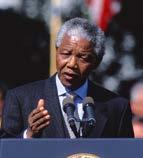
a Bangladesh
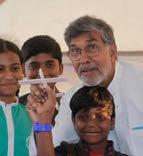
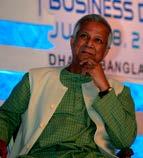
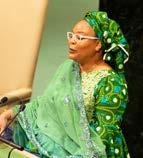
b Vietnam
c South Africa
d Liberia
e India
f Kenya


g Pakistan

h Guatemala
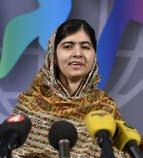
7
1 Malala Yousafzai
5 Rigoberta Menchú Tum
2 Nelson Mandela
6 Thich Nhat Hanh
3 Wangari Maathai
7 Leyman Gbowee
4 Muhammad Yunus
8 Kailash Satyarthi
THE RIGHT* TO AN EDUCATION
Malala Yousafzai
A secret blog
Malala was born on 12th July 1997 in the Swat valley in Pakistan, in a peaceful village called Mingora. The Yousafzai family, who were Pashtuns, were educated people. Malala’s grandparents were teachers and her father was a human rights activist*. Her parents named Malala, their first child, after a famous Pakistan heroine. In her country, male children are preferred but her parents welcomed her with great happiness. Malala was very intelligent and worked hard at school. She wanted to be independent and have a good job when she grew up.
At the end of 2007, the Taliban invaded the region where the Yousafzai lived and they had to go and live with relatives in Haripur. No entertainment was allowed, and women did not even have the right to do simple things like going to school, and were forced to wear the burqa*, something that Malala thought was really unfair. She worked in secret for the BBC, writing a blog about life in Pakistan and the things that women and children were not allowed to do. She wrote the blog under the name Gul Makai, “cornflower”. She also made two documentaries with the New York Times, one on
right: what a person is allowed to have or do, and not have it taken away activist a person who works hard to make important changes in society
8
2
burqa a dark veil worn by Muslim women which covers their face but not their eyes
“ I don't mind if I have to sit on the floor at school. All I want is education. And I'm afraid of no one.” ”

THE RIGHT TO AN EDUCATION
the schools closing and another on the problems of girl students. Everyone knew that Malala had written the Gul Makai blog. In December 2011, the Pakistan government gave her the National Peace Prize. At that time, the Taliban were losing control of the country and it seemed that life was returning to normal. She returned to Mingora, and more importantly, she was able to go back to school, even if she still had to wear the burqa. Malala was happy because she had missed going to school a lot.
The assassination attempt
On 9th October 2012, near exam times, Malala was on a bus with her schoolfriends, when two Talibans stopped the bus and asked where Malala was. When they saw her, they shot at her and hit her in the head. She was taken to hospital, first in Pashawar and then to Birmingham in Great Britain. Fortunately, she did not die. The Taleban had wanted to eliminate her just because she had become a symbol of the fight
Women in Pakistan
Still today, in Pakistan, women suffer discrimination*. Almost all women are not allowed to work, study or are not even free to leave their own homes. Some have to marry men who are much older than they are, even if they don’t love them. Women are considered less important than men. The birth of a baby girl is a problem for families and is not a happy event.
for the right to an education. Thousands of children from all over the world wrote to her in hospital. While she was there, she continued to read and study, and she realised that, sadly, she would have to make a new life for herself, far from her home country.
Her family could not return to their country because the Taliban had taken control of Pakistan again. However, thanks to the media attention around her attack, the United Nations
discrimination looking at people differently because of age, race or gender
10
started a petition* demanding that, by 2015, all children should be allowed to go to school. This was the first official document in Pakistan on the right to education. While Malala was living in Britain, the Pakistan President, Zardari, gave 10 million dollars to education and the Malala Foundation was also started to help girls all over the world to get an education.
The right to an education
On the day of her sixteenth birthday, Malala was invited to make a speech at the United Nations building in New York. In front of a very important audience, she spoke about her fight for the right to education and invited everyone to fight, in any way possible, for the right of every child, not just girls, to have an education. Education
is, in fact, the only way to fight discrimination. For the occasion, she wore the shawl* that had belonged to Benazir Bhutto, the political leader who had tried to change Pakistan.
In 2014, she became the youngest person to win the Nobel Peace Prize, which she shared with the Indian activist, Kailash Satyarthi, for their fight for all children to have an education. “Let us pick up our books and our pens, they are the most powerful weapons. One child, one teacher, one book, one pen can change the world.” Many schools petition a
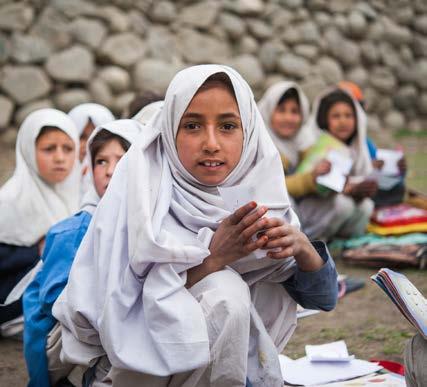
11
Schoolgirls in Pakistan.
document signed by many people to protest about something shawl a piece of cloth you wear on your shoulders
Malala Yousafzai
“ Education is power for women. The Talibans are closing girls’ schools because they don’t want women to have power.”
THE RIGHT TO AN EDUCATION The 2030 Agenda
The 2030 Agenda is a programme of action for all people, the planet and well-being. It was signed on 25th September 2015 by the 193 member countries of the United Nations and has 17 goals for sustainable development. These should be achieved by 2030 and are environmental*, economical and social in nature. The programme is not the answer to all world problems but is a good common base to start from and go towards building a different world that allows everyone to live in a sustainable way.
today remember her role as a female activist, especially on 20th November, when they celebrate World Children’s Day. Her work is based on ideas, but also on doing real things, like opening schools for people escaping from dangerous situations in their own countries.
She became one of the heroes of Global Goals, or the 2030 Agenda, together with many other activists and celebrities like Anastacia, Kate Winslet, Jennifer Lopez and Bill Gates. In 2015, world leaders promised, within fifteen years, to complete 17 goals towards sustainable* development. The most important goals include stopping extreme poverty, fighting against inequality* and injustice*, and stopping climate change*.
Together with her friend, Greta Thunberg, Malala has said that the climate crisis is having negative effects on basic human rights, like the right to education.
environmental regarding the environment, the natural world we live in sustainable helping the environment inequality not seen as the same as others, not being equal
injustice something that is not right or fair climate change when weather patterns become different because of pollution
12
“ When the whole world is silent, even one voice becomes powerful.”
No fear
Malala studied philosophy, politics and economics at Oxford University, so that she could become a politician and help give the women in her own country a future. She got her university degree in 2020 and then took some time during the pandemic to try and understand what she wanted to do with her life, like anyone of her age. In 2021, she married Asser Malik, in Birmingham, in an Islamic ceremony in the Urdu language.
I am Malala
This book tells the story of Malala’s life. She wrote it together with Christina Lamb, an international journalist and expert on Pakistan and Afghanistan. It is a very emotional story about her courage and her dream to change the world. “You must speak the truth. The truth will abolish fear”.

Malala continues her fight for civil rights, education and women’s rights. She does this with great courage and without any fear, telling the truth and as an international symbol for the women who are fighting for their right to education and freedom.

13
ACTIVITIES
Reading Comprehension
1 Choose the correct answer.
1 Malala is the name of:
a a teacher in Pakistan
b a heroine from Pakistan
c Malala’s grandmother
2 The burqa is:
a a dark veil
b a Taliban book
c something prohibited by Muslims
3 Where was Malala attacked?
a At school
b On a bus
c In front of her house
4 Which country did Malala have to live in?
a Afghanistan
b Italy
c Great Britain
5 In which city is the headquarters of the United Nations?
a London
b New York
c Paris
6 How many goals does the 2030 Agenda have?
a 20 b 15 c 17
2a Work with a partner. Discuss what the following words mean to you. Write a short definition of them and compare them with the class.
1 education: ......................................................................................................
2 inequality: .......................................................................................................
3 prohibited: ......................................................................................................
4 poverty: ...........................................................................................................
14
2b Now think about the opposite meaning of these words. Write a short definition of them and compare them with the class.
1 education: the opposite is ......................................................................
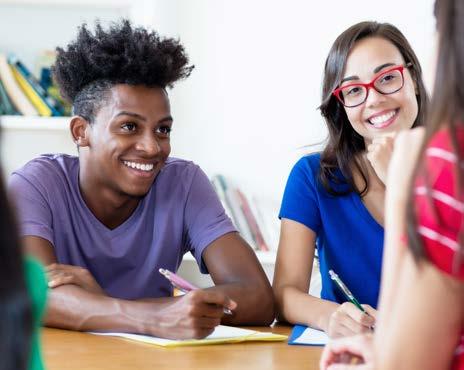
2 inequality: the opposite is ......................................................................
3 prohibited: the opposite is .....................................................................
4 poverty: the opposite is ...........................................................................
Writing
3 Imagine you are Malala. How would you start your autobiography? Start with “I am Malala.“
Roleplay
4 Work in pairs. Decide who will play the role of Malala and who will be the journalist. Write 5 questions and answers for a TV interview. You could also make a video of the interview with your mobile phone to show to your class.
15
I am Malala…
HUMAN RIGHTS
Nelson Mandela
From a tribe* to politics
Nelson Mandela was born 18th July 1918 into the Thembu royal family, a tribe of the Xhosa people from South Africa. His father was the head of the tribe and he grew up listening to stories about his ancestors* and their fight for freedom. He too dreamed of helping his people in their fight to be free. While he was studying law in Fort Hare, his great desire* for justice grew and when he organised demonstrations* with Oliver Tambo, his university told him to leave. He found a job as a guard* at the Crown Mines in Johannesburg and it was then that politics started to become an important part of his life. He decided not to become head of his tribe and he didn’t marry the woman that the village leaders had chosen for him, which was against his family traditions.
tribe group of people of same race ancestors family members born many years ago desire something you really want a lot demonstration crowds coming together to show they are against something guard a person who protects people or things
Mandela knew very well that it was education that would make him a good politician who would respect the rights of every person, especially the weakest.
“Education is the most powerful weapon which you can use to change the world”. In 1944, together with Oliver and Walter Sisulu, he formed the Youth League of the African National Congress, because he saw that his people were suffering and that the laws were becoming even more unjust and impossible to accept. This organisation fought for black South Africans to have the same rights as white people. After finishing his studies at a different university, he opened the first lawyer’s office for
16
3
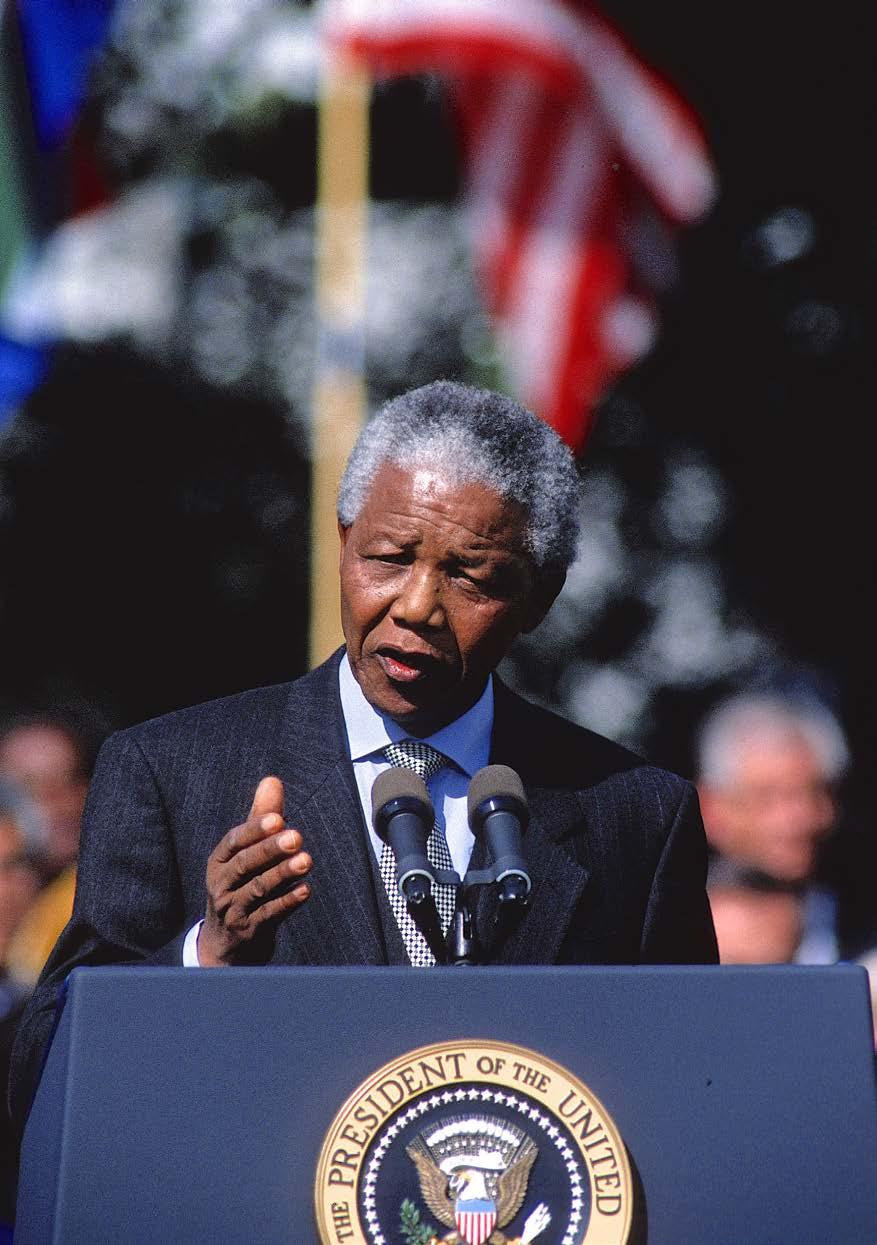
black people, the poor and social outcasts*.
During these years he helped to organise marches and non-violent demonstrations against discrimination. When Mandela was a young man, black people in South Africa had very few rights. They were not allowed to vote, become politicians or even buy land. Those were difficult years for non white people. In 1948, laws were passed to separate whites from blacks and so, apartheid began.
Apartheid
The word apartheid means “separation”. This was the word used to describe the policy of race discrimination decided by the white government in South Africa after the Second World War. Since the times of the first colonies in South Africa, less than 9% of the population was white, but the white people were more powerful. Whites and blacks had to live in separate areas. They weren’t allowed to marry, sit at the same table, take the same bus, or go to the same schools. Apartheid was finally officially abolished* in 1993 by the members of the United Nations.
Mandela loved that Gandhi’s demonstrations were peaceful because he believed that non-violence was the only possible way to solve the problems in his country. During his long life, he was sent to prison many times, the first time being in 1956. At the age of 46 he was sent to prison for life after a trial in Rivonia. He stayed in prison till 1990 and during these 27 years in prison he had no contact with the outside world. In this period he became
18
HUMAN RIGHTS
“ There is no easy road to freedom!!”
outcast
someone who is not wanted by others in society abolished eliminated, ended
The first black president
ill with tuberculosis but refused help from anyone. He believed that he was in prison unjustly and would never change his mind. In prison he studied a lot and exercised for an hour every day. He thought that sport could change the world because it brings people together. It speaks to young people in a language that they can understand and brings hope where there is very little. In sport there are no blacks or whites. There are only human beings who want to win.
When he became president, he used sport, especially rugby, as a way of uniting men and women and a way of rebuilding his country. Rugby is a sport with important human values.
In the Rugby World Cup in South Africa, Mandela used rugby, a sport usually played by white people, to bring his country together and make South Africans proud of their nationality.
He was the most famous political prisoner in the world and there were demonstrations all over the world in his name. In the meantime, little by little, things were changing in South Africa. For example, black students were allowed to go to universities for white people. Mandela understood that the only way to a better future in his country was to have a good and non-violent relationship between blacks and whites. Shortly after leaving prison on 11th February 1990,
“ I have cherished the ideal of a democratic and free society in which all persons live together in harmony* and with equal opportunities. It is an ideal which I hope to live for and to achieve. But if needs be, it is an ideal for which I am prepared to die.” .”
19
harmony living well together Nelson Mandela
Rosa Parks
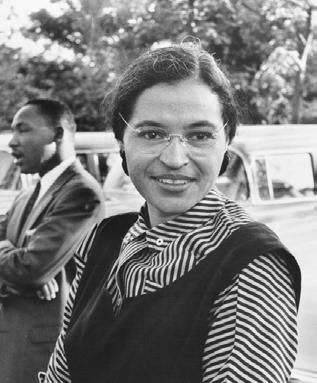
The story of Rosa Parks is a perfect example of how a simple action can change lives. In Alabama on 1st December 1955, Rosa was returning home from work by bus. She sat in the first row of the area where both blacks or whites could sit, but where a black person would have to give their seat to a white person. When the driver asked her a few minutes later to get up, Rosa refused. She said, “I wasn’t physically tired, I was just tired of giving in*”. This one small action changed history and led the world to justice and freedom.
thanks also to the South African President Klerk, his great popularity led him to becoming the first black President of South Africa.
His government was the first one to include different races and Mandela’s goal was to bring South Africa together in peace, to unite* white and black people. These were years of great change in his country. As President, he investigated crimes against human rights during apartheid and promoted peace in the different communities. He also signed a new democratic constitution* in 1997.
20
giving in surrendering, accepting what others want unite to bring or come together democratic constitution a law which makes all people equal
A legend
In 1999, Mandela retired from public life but continued with his humanitarian work and his fight for peace and human understanding, especially outside South Africa. The Nelson Mandela Foundation was started to make the world, not just South Africa, a better place to live in, by helping those suffering from discrimination and poverty, and fighting for their rights to freedom, education and health.
He is probably the politician who has received the most awards* in the world. As well as the Nobel Peace Prize in 1993, he received 250 other prizes! Mandela fought all of his life for black people’s rights and became a legend who was famous all around the world for his fight for social justice.
In 2009, the United Nations declared that his birthday, 18th July, would be celebrated as Nelson Mandela International Day, to promote* justice, peace and unity all over the world.
He died at his home in Johannesburg on 5th December 2013.
Nelson Mandela
21
award prize, something you win for doing something good promote to make important, encourage
“ Your freedom and mine cannot be separated. Freedom is indivisible”
Grammar
1 Complete the sentences with the correct time expression from the list below.
today • from that moment • in the year • when • while • that day • after • at that time
We are ________________ (1) 1955. Rosa Parks is returning home by bus, ________________ (2) working all day. ________________ (3) she is looking for a place to sit, she sees that there is only one free seat, near the special area where both whites and blacks can sit. ________________ (4) she sits down, the driver comes and asks her to get up. Rosa doesn’t get up. “________________ (5) I wasn’t physically tired, I was just tired of giving in”. This one small action changed history and ________________ (6) the world fought for justice and freedom. ________________ (7) apartheid is just a bad memory, but ________________ (8) it was a sad reality.
Writing
2 Answer the questions.
1 In what way did Nelson Mandela not follow his family traditions?
2 What is apartheid? .............................................................................................................................. ..............................................................................................................................
3 Why did Mandela believe that sport could change the world? .............................................................................................................................. ..............................................................................................................................
4 What is celebrated on 18th July and why? .............................................................................................................................. ..............................................................................................................................
22
ACTIVITIES
Think On!
The 2030 Agenda - Goal 10
3 Goal 10 of the 2030 Agenda is “Reduced Inequalities”. One of its targets 10.2 is: “empower and promote the social, economic and political inclusion of all, irrespective of age, sex, disability, race, ethnicity, origin, religion or economic or other status”. Target 10.3 is: “Ensure equal opportunity and reduce inequalities of outcome, including eliminating discriminatory laws, policies and practices”. In other words, making sure that all people of all ages, gender, race, religion and social status are treated the same and with no discrimination. What do you think about these ideas? Do you think it is talking about racism? What could be done to reach these goals?
Vocabulary
4 Choose a word from the box below and write it next to the correct definition. abolished • ancestors • demonstration • desire • outcast • unite
1 ......................................................: someone who is not wanted by others in society
2 ......................................................: something you really want a lot 3 ......................................................: to bring or come together 4 ......................................................: eliminated; ended 5 ......................................................: crowds coming together to protest against something 6 ......................................................: family members born many years before in the past
23
.................................................................................................................................. .................................................................................................................................. .................................................................................................................................. .................................................................................................................................. .................................................................................................................................. ..................................................................................................................................
Wangari Maathai
The Tree Woman
Wangari Maathai was born in 1940 in central Kenya when her country was still a British colony. At that time the female children of kikuyu farmers didn’t go to school, but her brother persuaded their mother to send his little sister to the village school. She was intelligent and interested in everything, so a teacher moved her to a primary school in Nyeri, where lessons were not in her tribe’s language, but in English. She quickly learned the new language and got excellent results in all her subjects. She became a Catholic and then went to the only girls’ high school in Kenya, at Limuru, near Nairobi.
Kikuyu
The kikuyu is the largest ethnic group of people in Kenya. They speak a language called kikuyu and are farmers who live in the central mountain areas between Nairobi and Mount Kenya. After the country got its independence in 1963, it became part of the Kenyan nation. The first famous kikuyu politician, Jomo Kenyatta, was the first president of the new state.
After finishing high school, she was one of 300 African students chosen by the American government to study in the United States, where she received a college scholarship*.
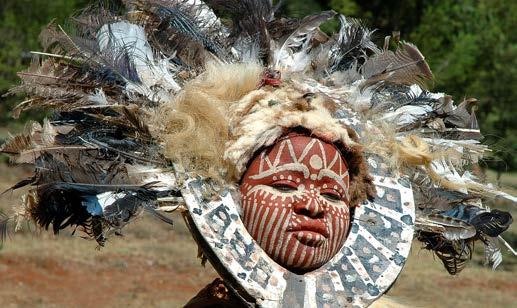
24
4 PROTECTING
THE ENVIRONMENT
scholarship money given to students to study at university
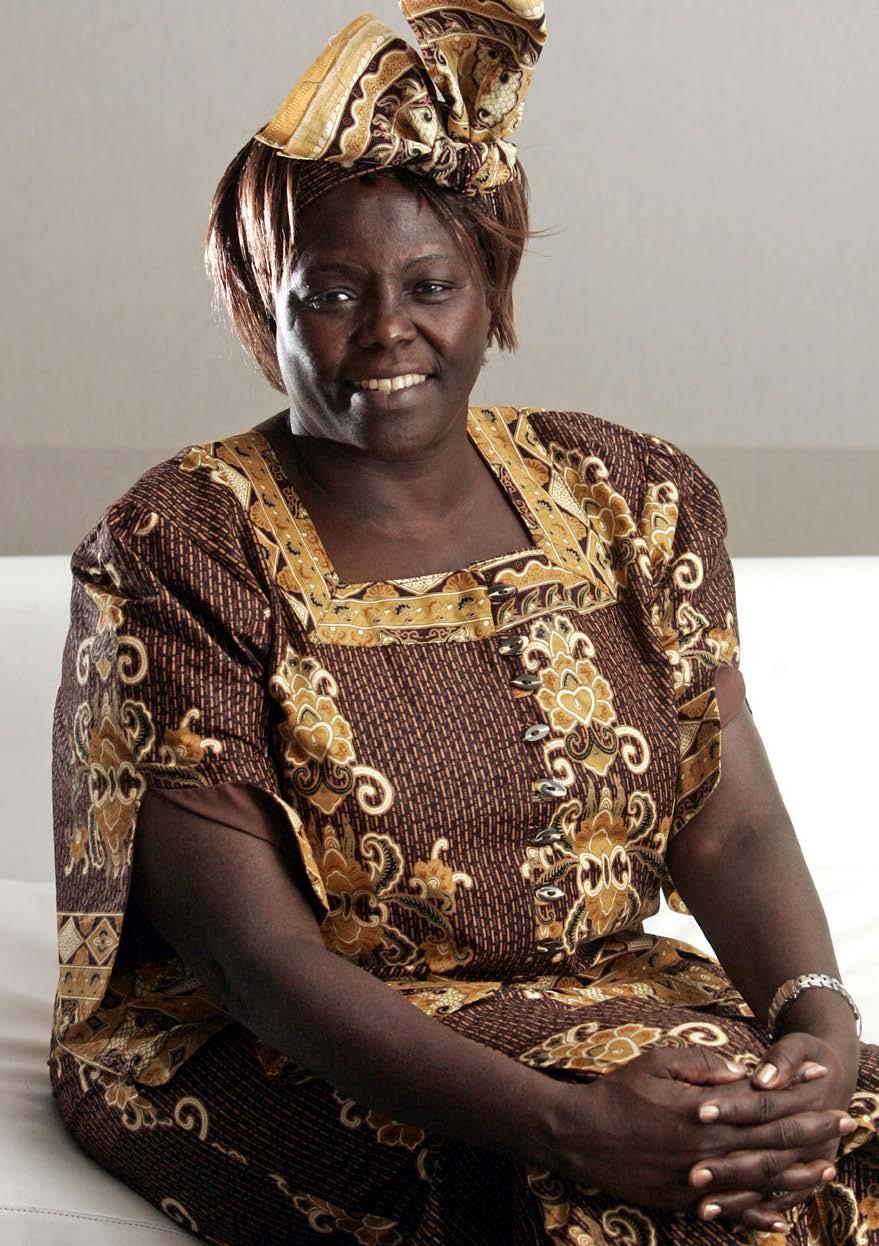

During this time, she worked in a laboratory, but didn’t have enough money to return to Kenya. She took part in African American civil rights demonstrations and environmental protests. When Kenya got its independence* from the United Kingdom, she was studying at the University of Pittsburgh. She became the first Central African woman to get a degree* in biological sciences. In 1966, after almost six years in the United States, she decided to
Now is the time
return to Kenya, and she never left it again.
She found work as an assistant in the veterinary* department at the University of Nairobi, where she continued to study and, in 1971, became the first woman to receive a PhD*. She began teaching veterinary science at the University of Nairobi and became president of the National Council of Women of Kenya. As a scientist and environmentalist, she was an example for many women.
While working all around Kenya, she saw with her own eyes the serious damage to the environment and population because of the natural vegetation being destroyed to grow tea and coffee plants. She met with the women from the area, who were suffering because the land was too poor to grow anything. There was no wood for fires and no fields where animals could eat grass. Also, there was no clean water to drink because the rivers were dry.
When she returned home, she saw that the lakes near her village were also starting to become dry and that the streams were no longer there. This was the moment when she decided that something had to be done to stop the deforestation* and protect the environment. Then she had a very clever idea. Let’s plant trees. And so began the story of the woman we now know as “the Tree Woman”.
independence being free from others to do what you want degree what you get when you finish studying at university veterinary type of medicine studied to care for animals
26
phD (= doctorate) an advanced university course after a degree deforestation taking away woods and forests
PROTECTING THE ENVIRONMENT
The Green Belt*
With the help of the other women in the villages, she collected seeds from the forest, planted them, watered them and cared for them, until the plants were thirty centimetres high. There were indigenous* trees, small plants and fruit trees and the women took great care of them, just like their own children. On World Environment Day, 5th June 1977, they planted 7 trees in a park just outside the Kenyan capital. These trees formed the first “green belt”,

Biodiversity
Biodiversity is the marvellous variety of living things on our planet, which act with each other inside particular ecosystems*. However, human actions are causing pollution*, intensive farming*, desertification*, deforestation and climate change, which are all bad for biodiversity. This will cause great damage to the environment, animals and plants. Protecting biodiversity and ecosystems means taking care of air quality, land and water, and not disturbing the seas, oceans, forests, grasslands and other ecosystems
27
ecosystem biological community of living things pollution dangerous things in the air or water
intensive farming farming which takes the most out of the land desertification making land dry and without water
green belt area with no buildings, only trees and plants indigenous living in the place where you were born
Wangari Maathai
“ The future of the planet concerns all of us, and all of us should do what we can to protect it. As I told the foresters, and the women, you don't need a diploma to plant a tree.”
PROTECTING THE ENVIRONMENT
which gave its name to the ecological movement, the Green Belt Movement.

Her new and amazing idea was to plant millions of trees, which she managed to do by informing everyone about the problems facing nature and particularly, deforestation. Over 51 million trees were planted in Kenya, more than the population of the country. In the same way that a tree grows from a small seed, this idea grew and gave birth to a great movement which went beyond the borders of Kenya.
The Green Belt Movement opened the way to social development, from protecting
the environment to fighting discrimination against women and allowing them to work. In fact, Wangari said that the poverty in her country was related to environmental problems and that the solution was to get women involved.
Since 1977, over 30,000 women in Kenya’s countryside have grown plants, planted trees, kept beehives* and collected rainwater, all jobs which have earned them money. The Green Belt Movement is still working today to create new jobs for women, fight deforestation and protect the biodiversity of the plant and animal life in the world. Wangari became an “ecofeminist”.
beehives houses for bees
“
Anybody can dig a hole and plant a tree. But make sure it survives. You have to nurture it, you have to water it, you have to keep at it until it becomes rooted so it can take care or itself.””
The well-being of Africa
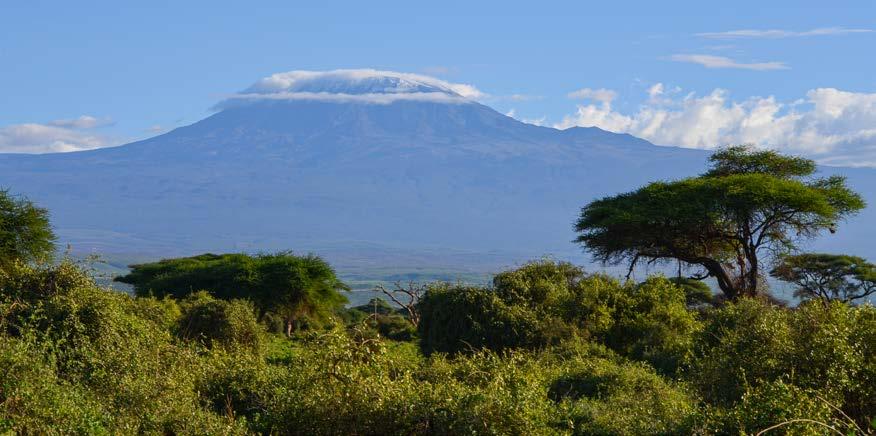
After leaving her job at the university, she continued her fight for the environment and became the African symbol of the fight for peace and well-being on the African continent. She worked for the human rights of women and children, in particular, for democracy and a multi-ethnic society. Her work made the whole world aware* of the problems of women, especially African women, whom she helped to fight for a better life.
“ I want to do the right things - I want to plant trees, I want to make sure that the indigenous forests are protected because I know, whatever happens, these are the forests that contain biodiversity, these are the forests that help us retain water when it rains and keep our rivers flowing, these are the forests that many future generations will need.”
Wangari is the first African woman to win the Nobel Peace Prize for “her contribution to sustainable development, democracy and peace”. She decided to celebrate this in the way she knew best: by planting a tree in the red earth of the valley of Mount Kenya.
aware notice
Wangari Maathai




































